
99
Journal of Development and Integration, No. 78 (2024)
K E Y W O R D S A B S T R A C T
DEA,
Blockchain,
Smart contracts,
Supply chain
management,
Transparency.
In the context of a complex and demanding business environment, blockchain and smart
contracts are becoming increasingly important in supply chain management in Vietnam.
The application of these technologies can help to optimize processes, create a reliable
platform for tracking, managing, and forecasting supply chains, and enhance transparency
and integrity. In the study of supply chain management in Vietnam, the methods applied
are DEA (Data Envelopment Analysis) and the Grey forecasting model. These two
methods not only focus on optimizing current processes but also create opportunities
for analyzing, evaluating, and forecasting the importance of blockchain technology and
smart contracts.
This research topic not only raises questions about the potential for optimizing current
processes, but also proposes innovative solutions to enhance transparency, integrity, and
responsiveness to volatile markets. Additionally, the research aims to propose appropriate
strategies for applying these new technologies to business practices in Vietnam, creating
a flexible, secure, and adaptable supply chain system that is responsive to the changing
business environment of the present.
Analysis and forecasting of the importance
of smart contracts and blockchain technology in SCM
in Vietnam by using DEA and Grey model
Tran Kim Phong1, * , Le Thi Diem Trinh2
1SW CHANNEL Media and Advertising Company Limited., Ltd, Vietnam
2People’s Police University, Vietnam
* Corresponding author. Email: jasonkim@swvietnam.com
https://doi.org/10.61602/jdi.2024.78.13
Received: 22-Feb-24; Revised: 23-May-24; Accepted: 07-Jun-24; Online: 31-Aug-24
ISSN (print): 1859-428X, ISSN (online): 2815-6234
1. Introduction
In the current context of rapidly evolving
business environments, the integration of innovative
technologies like blockchain and smart contracts has
emerged as a crucial focal point for enhancing efficiency
and transparency in supply chain management. This
research delves into the Vietnamese context, aiming
to critically analyze and forecast the pivotal role of
these technologies in reshaping the country’s supply
chain dynamics.
The urgency of this study is underscored by
Vietnam’s burgeoning economic context, where the
optimization of supply chain processes has become
imperative for sustainable growth and competitive
advantage. The need to explore the application and
No. 78 (2024) 99-106 I jdi.uef.edu.vn

Journal of Development and Integration, No. 78 (2024)
100
impact of blockchain technology and smart contracts
within this context is paramount, given their potential
to revolutionize traditional supply chain practices.
A number of studies have explored the potential
benefits of blockchain and smart contracts for SCM.
For example, a study by the World Economic Forum
found that blockchain could save businesses up to
$10 billion per year by 2025 (Cann, 2016). A study by
IBM found that smart contracts could save businesses
up to 20% on transaction costs (IBM, 2016).
This research endeavors to address the fundamental
query regarding the potential and relevance of
blockchain and smart contracts within Vietnam’s
supply chain ecosystem. By employing the Data
Envelopment Analysis (DEA) and Grey forecasting
models, the study seeks to identify their efficacious
integration strategies and forecast their transformative
influence. The core objectives include assessing their
potential in enhancing transparency, efficiency, and
adaptability in supply chain operations, offering
insights crucial for strategic decision-making and
fostering innovation in the Vietnamese business
context.
This study’s significance lies in its contribution to
the academic discourse on the practical applications of
blockchain and smart contracts in a specific regional
context. It aims to provide actionable insights for
businesses and policymakers, facilitating informed
decisions to optimize supply chain processes, bolster
competitiveness, and navigate the evolving market
context efficiently.
2. Literature Review and Methodology
2.1. Literature review
The literature on the application of blockchain
and smart contracts in supply chain management
is growing rapidly. A number of studies have
explored the potential benefits of these technologies,
including:
The article “Improving Hyperconnected Logistics
With Blockchains and Smart Contracts”of Quentin
Betti et al was explores how blockchain technology
can be used to improve hyperconnected logistics
systems, which are characterized by extensive
interconnectedness and real-time data sharing. It
highlights the potential benefits of blockchain in
enhancing transparency, security, efficiency, and
sustainability within these systems (Betti et al., 2019).
The simulation models a simplified “megacity” with
different zones and hubs. Shipments are transported
between zones by couriers, riders, and shuttlers. A
blockchain-enabled tracking system is implemented
to store shipment tracking data. Each agent has an
account on a private Ethereum blockchain network and
can submit transactions containing tracking actions.
Smart contracts are used to store the actions. The
implementation allows the agents to share a common,
trusted tracking system rather than isolated systems.
It also enables adding new agents easily regardless of
company affiliation.
Potential issues include blockchain size and
redundant data, access control and confidentiality
of data, and performance limitations of blockchain
platforms. Solutions are proposed such as storing
only hashes on-chain. The paper demonstrates
the applicability of blockchain to hyperconnected
logistics in the Physical Internet vision, though some
challenges remain to be addressed. Overall it provides
a valuable practical example and analysis (Betti et al.,
2019).
In other research “An Application of Ethereum
smart contracts and IoT to logistics” of Leonor
Augusto et al. This article proposes a blockchain
application for use in logistics, utilizing IoT devices to
track a product’s journey. A smart contract system is
implemented with an RBAC system, product tracking
and a clearance/quality control system, providing
trustworthy information on the products being supplied.
Our blockchain application uses smart contracts and
RBAC to ensure secure tracking updates. IoT devices
with limited permissions are associated to their
owners and can only generate readings for products
whose bearer corresponds to their owner entity.
Authors have developed a blockchain smart contract
system to manage products in a logistics system, with
features such as Role Based Access Control, product
tracking and tracing and semi-automatic clearance
procedures. However, there are limitations to applying
these solutions to real-world use, such as scalability,
storage and integration difficulties (Augusto et al.,
2019). Besides that, the research of Omar Alkhoori
et al with the name “Design and Implementation of
CryptoCargo: A Blockchain-Powered Smart Shipping
Container for Vaccine Distribution” was show
that DApp is developed to monitor GPS violations
using Web3.js, Google Maps APIs, and Bootstrap.
Data from the blockchain is decoded and displayed
to the user, while Canvas.js is used to display a pie
Tran Kim Phong et al.

101
Journal of Development and Integration, No. 78 (2024)
chart visualizing the violations recorded on the
blockchain. They used used Infura to access an
Ethereum node, Metamask to generate an Ethereum
wallet, and Remix to deploy a smart contract. Web3.
min.js was downloaded and imported into our code,
and Web3 provider was defined through an HTTP
link to our Infura endpoint. ABI was used to create
the Web3 contract instance. The research introduced
a blockchain-powered solution, CryptoCargo, that
tracks shipments and identifies threats to the health
of the package. The solution uses cloud-based
services to achieve real-time communication with the
smart container and accurate reporting and analytics
(Alkhoori et al., 2021).
Future research could focus on mitigating
scalability issues, refining integration methods,
and exploring practical implementations of these
technologies to address real-world supply chain
complexities. Additionally, investigating regulatory
and standardization aspects could pave the way for
widespread adoption.
2.2. Methodology
In order to achieve the goals of this study, the
following mathematical model and process will
guide the authors. This study will take 6 cases of
6 Logistics company in the world then use DEA
model to know how infection of them and use Grey
forecasting model to forecast the importance of this
kind of advantage in Logistics field. The results must
be consistent with the purpose of the paper.
2.1.1. Research Framework
Figure 1 describes how will the process of research
be along with each defining procedures.
Phase 1. The historical data were gathered from
web database of Morningstar.com, a global market
research firm. These past data values will be used as
the preliminary values (historical data) for the Grey
prediction model.
Phase 2. The application of the GM (1,1) is to
Figure 1. The research process flowchart
Tran Kim Phong et al.

Journal of Development and Integration, No. 78 (2024)
102
assist for uncomplicated forecasting by using only a
minimum of four years historical data. The forecast
will then be used in the process of DEA for evaluation
of performance.
Phase 3. All of the data, historical and future, will
be processed using DEA Window model to calculate
the efficiency during the certain periods. The authors
will use the 2-window setup to have a comprehensive
comparison between the past and the future.
2.1.2. Grey Model and MAPE
Based on a time series domain with differential
equations in forecasting data, the GM has gained its
popularity to many users. It became more popular
due to its capabilities to produce acceptable and
reliable forecast that requires only at least four
period of historical data, Ju-long (1982) and Tseng
(2001) (Khan, 2023). The process of GM is described
below:
- Series x0 will be encoded as historical data
- Then x0 generates the values for x1(k)
- A partial data will be generated from x1(k) which
is z1(k)
- The calculation of coefficient a and grey input b
- Construction of GM (1,1) forecasting equation
- Calculation of average residual y
Using x0 as a primitive variable series, the process
of the prediction method is described in Equation
(1).
X(0) = [x(0)(1), x(0)(2),…, x(n)], n ≥ 4 (1)
Wherein x0 is a positive sequence together with
the total number of historic data n.
Where n is the total count of historic data along
with a positive sequence x0. A minimum of four
historic data is required to facilitate prediction process
using grey model. This property is very necessary
which makes the model an advantageous method in
forecasting.
Equation (2) describes the partial data series:
z(0) = [z(1)(1), z(1)(2),..., z(1)(n)] (2)
Where the mean value z1(k) is also defined in
Equation (3) as:
Z(1)(k) = 1/2 x [X(1)(k) + X(1)(k-1)]
k = 2,3,…, n (3)
The first order differential equation x(1) (k) of
grey model can be acquired through Equation (4) as
described by Julong (1989):
In which represents the predicted
value of x at k +1 point in time. The values of [a,b]
T will be generated using the ordinary least square
(OLS) method as defined by Equations (6) to (8).
[a,b]T = (BTB)-1BTY (6)
The least square method, Equation (5), will be
used to solve the above equation.
In which [a,b]T is the parameter series, Y and
B are referred to as the data series and data matrix,
consecutively.
The values is calculated by having
as the predicted series.
in which is equal to x(0)(1)
The final equation (11) can be obtained by applying
the inverse accumulated generation operation
(AGO).
X(0)(k+1) = (X(0)(1) – b/a)e-ak(1-ea) (9)
Mean absolute percentage error (MAPE) measure
the accuracy of the predicted values and is defined by
Equation (11).
(7)
(8)
(10)
The MAPE of the predicted data represents its
acceptability rate. Wherein lower value depicts
highly accurate predictions while higher value means
otherwise. Accuracy table was categorized into four
by as displayed in Table 1.
In this study, another nonparametric model of
DEA will be used and is referred to as the Window
model. In this mathematical model, n is considered to
be the summation of all the units being observed and
will be called the DMUn while the input variable is
m and output variable is s. Integrating an element of
time series t, it will become . Then, the input
and output generated into a vector called and ,
Tran Kim Phong et al.
(4)
(5)

103
Journal of Development and Integration, No. 78 (2024)
The DEA Window analysis will commence right
after the input and output were substituted to the
equation (Öztürk et al., 2022).
3. Results and Discussion
3.1. Selection of DMUs
Another crucial task in the research process is
the proper selection of the decision-making units
(DMUs). These are the subjects in which the data
will be gathered upon and will represent the whole
Logistics industry in the world. So, the authors have
MAPE Categorical Value
10% and below Highly Accurate
10 to 20% Moderately Accurate
20 to 50% Acceptable
51% and higher Unacceptable
DMU Logistics Company
DMU1 IBM
DMU2 Walmart
DMU3 Procter & Gamble
DMU4 Deloitte
DMU5 Maersk
DMU6 UPS
Input Description
Retirement-related
plans–cost (RRC)
Retirement plan costs encompass fees for fund management, administrative expenses, and investment-related charges.
The choice of plan often depends on individual preferences, employer offerings, and long-term financial goals.
Total operating costs
(TO)
Total Operating Costs (TO) encompass all expenses associated with a business’s regular operations. The formula to
calculate TO typically involves summing up the costs related to production, administration, and day-to-day activities.
Recorded investment
(RI)
Pre-tax refers to financial figures or amounts that are calculated or reported before taxes are deducted. It denotes income,
profits, expenses, or deductions that haven’t yet had taxes subtracted from them.
Amortized cost (A)
Amortized cost refers to the gradual allocation of a certain expenditure or expense over a specific period. It involves
spreading out the cost of an asset or expense incrementally across its useful life, reflecting a more accurate representation
of its impact on financial statements.
Output Description
Revenue (R) Revenue represents the total income generated by a company from its primary operations, typically from sales of goods or
services
Net income (NI) It represents the company’s profitability, calculated by subtracting operating expenses, taxes, interest, and other costs from
the total revenue
Table 1. MAPE equivalent forecast categories
as describe by the Equations (11) and (12).
(11)
(12)
(13)
(14)
The point k (1≤k≤T) is the starting point in time
T and has a width magnitude w (1≤w≤T-k) , wherein
each window kw will be represented by the input
matrix Xkw and output matrix Ykw as shown in the
equations below.
Table 2. List of Logistics company in the world which
applied Blockchain in supply chain management
Table 3. Input and output factors and definitions
selected those company which have been a contributor
not only to the industry but also to the country. Table
2 shows the list of the Logistics enterprise which
applied the blockchain in their own product.
With the rapid development of the Logistics
company, more and more company are emerging
and participating in this potential market with many
different way of management.
3.2. Identifying Input and Output Factors
After the significant DMUs have been selected,
the next step is to identify the input and output factors
that will be considered for the analysis. These factors
must have important impact to the performance of the
logistics company. The thesis consider those factors
that are commonly used by the previous studies.
Table 3 lists down the input and output factors and
their definitions.
Tran Kim Phong et al.

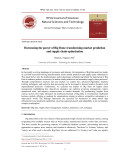


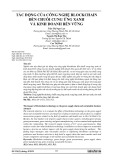

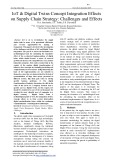
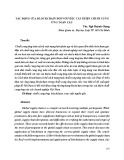

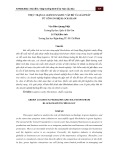
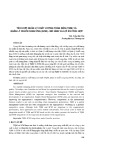







![Đề kiểm tra Quản trị logistics [mới nhất]](https://cdn.tailieu.vn/images/document/thumbnail/2025/20251015/2221002303@sv.ufm.edu.vn/135x160/35151760580355.jpg)
![Bộ câu hỏi thi vấn đáp Quản trị Logistics [năm hiện tại]](https://cdn.tailieu.vn/images/document/thumbnail/2025/20251014/baopn2005@gmail.com/135x160/40361760495274.jpg)






